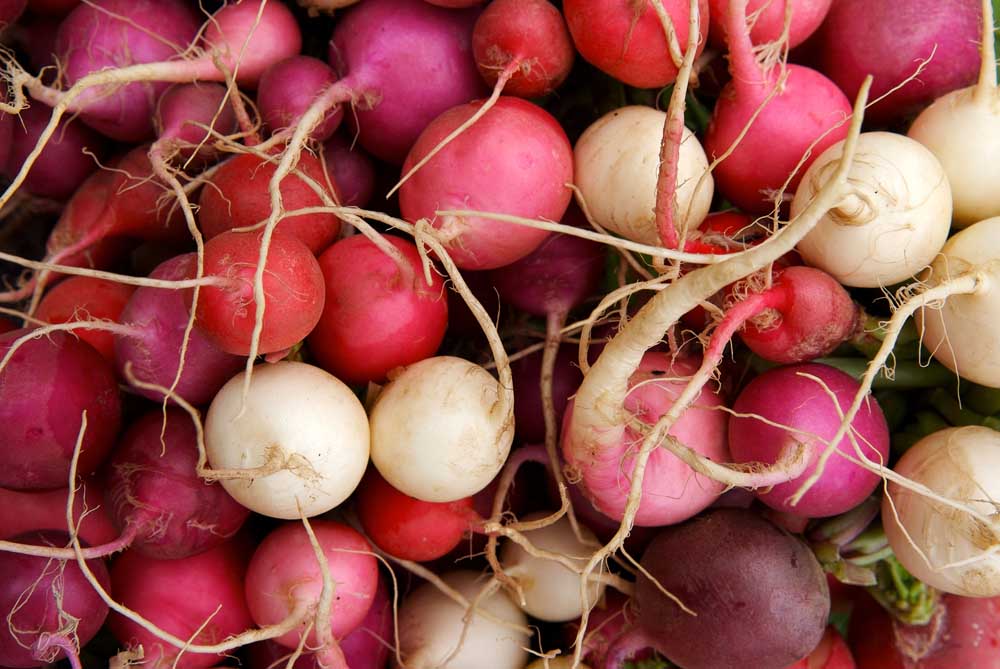Hot radishes add a kick to a variety of dishes
Published 7:39 am Tuesday, January 10, 2017

- Radishes can stimulate your appetite and open up your sinuses. (Dreamstime/TNS)
In winter, we love to feel the burn.
On blustery days, hot radishes, a staple of cuisines worldwide, open our sinuses and conquer our colds. They stimulate our appetite and make our mouths water. Prime rib and sushi wouldn’t be the same without them.
Trending
Horseradish, daikon and wasabi — the most popular of the hot radishes — share more than common cabbage cousins. They all contain allyl isothiocyanate (AITC), which stimulates our noses as well as our tongues. (Mustard and mustard seed have this compound, too.)
Although ingesting too much can be physically painful, this compound also makes us feel warm — a satisfying asset for any cold-weather food.
“I am lucky in that I rarely catch a cold or have congestion issues, but I would go straight for the horseradish or wasabi if I did,” said Terri Gilliland, who owns Lucky Dog Ranch in Dixon, California, with her husband, Ron, along with Lucca and Roxy restaurants in Sacramento.
On their ranch, the Gillilands raise their own all-natural beef. Horseradish is an indispensable condiment with big beef roasts such as prime rib.
“My favorite part of having prime rib is the horseradish,” Gilliland said. “The one time we made it ourselves, it was so strong, I thought we made a misstep, but then read that using fresh root is always going to produce a much stronger version than one you would buy.”
“Prepared” horseradish — the stuff that comes in a jar — is a mix of fresh grated horseradish preserved with vinegar and seasoned with a little salt and a dash of sugar. To make your own, use 1 cup grated fresh horseradish root to 1/2 cup white, rice or wine vinegar, then season to taste. It will keep in the refrigerator for weeks.
Trending
Horseradish also spices up sauces, mashed potatoes and even apple tarts. Eaten in Europe for centuries, it’s been part of American cuisine since the first colonists. Pioneers brought it to California. Back in Sacramento’s Gold Rush days, Mark Twain likely enjoyed it grated on fresh oysters.
Wasabi, a treasured delicacy in Japan for more than 1,000 years, is a more recent California transplant. With the rise in popularity of sushi and other Japanese cuisine, wasabi — or wasabi substitute — has become as prevalent in flavorings as its western cousin, horseradish.
Horseradish and wasabi are actually closely related, as both are members of the cabbage or mustard family. Wasabi is often referred to as “Japanese horseradish.” Likewise, horseradish is known in Japan as “Western wasabi.” Because wasabi is so expensive, horseradish is often substituted for real green wasabi.
While horseradish is an edible root, true wasabi is made from the plant’s rhizomelike stem. Wasabi is a tricky herb to grow; it’s native to the banks of ice-cold mountain creeks with its roots constantly bathed in chilly running water. Horseradish is far less finicky. Harvested year round, it’s sweetest and most available in winter and early spring.
Meanwhile, daikon is a dependable (and delicious) workhorse. This oversized radish not only serves as a spicy condiment, but doubles as a salad or root vegetable, tasty both raw or cooked.
Almost everyone remembers the first time they tried horseradish, wasabi or daikon. That moment usually came with tastebud alarms.
“Close to 30 years ago when Ron and I met, he took me to dinner in San Francisco and, in my Colorado rancdh girl ignorance, I thought the ‘green stuff’ on the appetizer plate was avocado and ate the whole spoonful in one bite,” Gilliland recalled.
“It was wasabi and I thought I was going to die. I had to run to the ladies room to splash cold water on my face just for some relief. Ron, of course, thought the whole thing was hysterical.”
Suzanne Ashworth of Del Rio Botanical in west Sacramento has plenty of hot radish experience, both as a farmer and cook. Del Rio supplies several Sacramento area restaurants with organically grown radishes as well as many other vegetables.
“My favorite horseradish recipe includes tomatoes, so it is best made before it freezes,” Ashworth said. Her hot tomato relish uses up a lot of late tomatoes as well as onions, bell peppers and 3⁄4 pound horseradish.
Ashworth recommends a wasabi cousin as a substitute for pricey wasabi — wasabi arugula.
“Regular ‘wasabi’ is just mustard and horseradish, dyed green,” she said. “Wasabi arugula has a different, more fleeting heat — like expensive wasabi has. Cut into small strips, it is eaten like wasabi.”
Wasabi arugula, available in some farmers markets, also can be processed to resemble green wasabi paste.
Shrimp Cakes with Avocado-Wasabi Sauce
For the shrimp cakes:
1 lb peeled and deveined lg (26-30 count) shrimp, finely chopped
1 C whole-wheat panko bread crumbs, or more as needed
1⁄4 C finely chopped, seeded red bell pepper
3 TBS finely chopped scallion greens
2 TBS roasted sesame seeds
1 lg egg, lightly beaten
1 TBS chopped fresh cilantro
1 tsp finely grated peeled fresh ginger root
2 tsp toasted sesame oil
11⁄2 tsp fresh lime juice
1⁄2 tsp salt
1⁄2 tsp freshly ground black pepper
1⁄4 C canola or other neutrally flavored oil
For the sauce:
Flesh from 1 ripe avocado
1 TBS fresh lime juice, or more as needed
1⁄2 tsp prepared wasabi paste, or more as needed
1⁄4 tsp salt
For the shrimp cakes: Combine the shrimp, half of the panko, the bell pepper, scallions, roasted sesame seeds, egg, cilantro, toasted sesame oil, ginger, lime juice, salt and black pepper in a mixing bowl, stirring until just combined. If the mixture seems overly moist, stir in more panko a tablespoon at a time. Spread the remaining panko in a shallow bowl; you’ll need about 1⁄2 cup for coating, so you may have to add a bit if you used more for the mixture. Divide the shrimp mixture into 12 equal mounds, then shape each one into a patty about 21⁄2 inches wide and about 1⁄2-inch thick. Coat each patty well with the remaining panko.
Place the cakes in the refrigerator for 20 to 30 minutes to firm up.
Meanwhile, make the sauce: Use a fork to mash together the avocado, lime juice, wasabi paste and salt in a medium bowl until smooth. Taste, and mix in more wasabi paste as needed. The yield is 3⁄4 cup. If not using right away, cover with plastic wrap directly on the surface and refrigerate until ready to serve (or up to 2 days in advance).
Heat the oil in a large nonstick skillet over medium heat. Once the oil shimmers, add as many shrimp cakes as will fit in the pan without crowding. Reduce the heat to medium-low; cook until the cakes are golden brown on both sides and cooked through, about 5 to 6 minutes per side. Just before serving, taste the avocado-wasabi sauce; add lime juice and/or wasabi, as needed. Dollop 1 tablespoon of the sauce on each shrimp cake.
— Recipe adapted from Ellie Krieger








